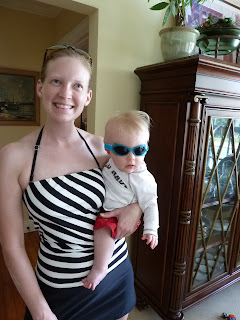 |
| Lawson chews everything now |
Lawson's 6 month stats:
Weight 17lbs 9 oz. 50th %
Height 26.5 inches 50th%
he has caught up in height from the 25th%
(even with the drooling.. no teeth yet)
We received great news at the doctors office yesterday. Lawson's head shape is improving as is his neck movement to his left side. It has taken a lot of work. Several people have asked questions about his head issue called Plagiocephaly. Here is some information I found about it:
Plagiocephaly is a condition that causes a baby's head to have a flat spot (flat head syndrome) or be misshapen.
The most common form is positional plagiocephaly. It occurs when a baby's head develops a flat spot due to pressure on that area. Babies are vulnerable because their skull is soft and pliable when they're born.
Positional plagiocephaly typically develops after birth when babies spend time in a position that puts pressure on one part of the skull. Because babies spend so much time lying on their back, for example, they may develop a flat spot where their head presses against the mattress.
Starting in the early 1990s, parents were told to put their babies to sleep on their back to reduce the risk of SIDS. While this advice has saved thousands of babies' lives, experts have noticed a fivefold increase in misshapen heads since then.
More rarely, babies develop positional plagiocephaly when movement in the uterus is constricted for some reason – because their mother is carrying more than one baby, for example. It can also happen to breech babies who get wedged under their mother's ribs.
Spotting positional plagiocephaly
Many vaginally delivered babies are born with an oddly shaped head caused by the pressure of passing through the birth canal. This usually corrects itself within about six weeks. But if your baby's head hasn't rounded out by age 6 weeks – or if you first notice that your baby has a flat spot on her skull after 6 weeks of age – it's probably a case of positional plagiocephaly.
Plagiocephaly shows up most often in babies who are reported to be "good sleepers," babies with unusually large heads, and babies who are born prematurely and have weak muscle tone.
Babies with torticollis can also develop a flat spot on their skull because they often sleep with their head turned to one side. Torticollis occurs when a tight or shortened muscle on one side of the neck causes the chin to tilt to the other side. Premature babies are especially prone to torticollis.
What to do if your baby's head develops a flat spot
Everyone's skull is a bit asymmetrical. And in many cases, a flat spot on a baby's head will round out on its own around 6 months of age, as she starts crawling and sitting up. Nevertheless, if you notice flattening of your baby's head at any time, don't wait – talk with her doctor about it right away.
A baby's skull becomes less soft and pliable as she grows. So if you do need to take steps to correct the condition, the younger your baby is, the easier it will be. Your baby's doctor may refer you to a specialist, such as a pediatric plastic surgeon or neurosurgeon for diagnosis and treatment.
We are so happy Lawson does not need treatment for his plagiocephaly. We have kept him upright when he is awake, made him do tummy time when he hated it, completed neck exercises daily, and worried about it daily. Plus the cost of the helmet to fix it not being covered my insurance made me extremely mad!
Lawson's 6 month Milestones
- he can sit up right and reach down to grab items with out falling over.. he has even learned to scoot his legs to help with balance
- he can put a spoon to his mouth
- hold his sippy cup and put it to his mouth
- stand up with very little support
- rotate around while on his belly
- scoot backwards on his belly by using his knees
- PICK UP AND PUT HIS BINKIE BACK IN HIS MOUTH!!
- help you get himself out of the car seat.. the minute you unstrap him hes leaning forward for you to grab him
Have a great weekend !




























